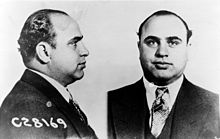Mug shot: Difference between revisions
slang term |
|||
| Line 3: | Line 3: | ||
[[File:AlCaponemugshotCPD.jpg|thumb|1931 mug shot of American gangster [[Al Capone]]]] |
[[File:AlCaponemugshotCPD.jpg|thumb|1931 mug shot of American gangster [[Al Capone]]]] |
||
A '''mug shot''', '''mugshot''' |
A '''mug shot''', '''mugshot''' is a [[slang]]<ref> [http://dictionary.cambridge.org/dictionary/british/mugshot?q=mugshot ''mugshot'' in Cambridge Dictionary] </ref> term for '''police photograph''', or '''booking photograph''', is a [[portrait photography|photographic portrait]] typically taken after a person is [[arrest]]ed.<ref>{{citebook|pages=147|title=Handbook of Illinois Evidence|author=Michael H. Graham|isbn=978-0-7355-4499-4|publisher=[[Aspen Publishers]]|year=2003}}</ref> The purpose of the mug shot is to allow law enforcement to have a photographic record of the arrested individual to allow for identification by victims and investigators. Most mug shots are two-part, with one side-view photo, and one front-view. They may be compiled into a [[mug book]] in order to determine the identity of a criminal. In high-profile cases, mug shots may also be published by the media. |
||
However, the term is sometimes used for a similar format photographic portrait taken for any reason, not necessarily involving formal arrest. For example, the process of applying for a [[security clearance]] or a [[passport]] may require the applicant to submit a mug shot photo. |
However, the term is sometimes used for a similar format photographic portrait taken for any reason, not necessarily involving formal arrest. For example, the process of applying for a [[security clearance]] or a [[passport]] may require the applicant to submit a mug shot photo. |
||
Revision as of 23:48, 9 October 2013

A mug shot, mugshot is a slang[1] term for police photograph, or booking photograph, is a photographic portrait typically taken after a person is arrested.[2] The purpose of the mug shot is to allow law enforcement to have a photographic record of the arrested individual to allow for identification by victims and investigators. Most mug shots are two-part, with one side-view photo, and one front-view. They may be compiled into a mug book in order to determine the identity of a criminal. In high-profile cases, mug shots may also be published by the media.
However, the term is sometimes used for a similar format photographic portrait taken for any reason, not necessarily involving formal arrest. For example, the process of applying for a security clearance or a passport may require the applicant to submit a mug shot photo.
History

The mug shot was invented by Allan Pinkerton, a US detective of the 19th Century. The Pinkerton National Detective Agency first began using these on Wanted posters from the Wild West days. By the 1870s the agency had amassed the largest collection of mug shots in the United States.[3]
The paired arrangement may have been inspired by the 1865 prison portraits taken by Alexander Gardner of accused conspirators in the Lincoln assassination trial, though Gardner's photographs were full-body portraits with only the heads turned for the profile shots.
The arrested person is sometimes required to hold a placard with name, date of birth, booking ID, weight, and other relevant information on it. With digital photography, the digital photograph is linked to a database record concerning the arrest.[citation needed]
Etymology
The term derives from "mug", an English slang term for "face", dating from the 18th century.[4]
The phrase is also sometimes used to refer to any small picture of a face used for any other reason.[5]
Prejudicial nature
The US legal system has long held that mug shots can have a negative effect on juries. The United States Court of Appeals for the District of Columbia Circuit held "The double-shot picture, with front and profile shots alongside each other, is so familiar, from 'wanted' posters in the post office, motion pictures and television, that the inference that the person involved has a criminal record, or has at least been in trouble with the police, is natural, perhaps automatic."[6]
The Handbook of Massachusetts Evidence says "Because of the risk of prejudice to the defendant inherent in the admission of photographs of the 'mug shot' variety, judges and prosecutors are required to 'use reasonable means to avoid calling the jury's attention to the source of such photographs used to identify the defendant.' " (p.617) Elsewhere it cites a ruling in Commonwealth v. Martin that "admission of a defendant's mug shot is 'laden for characterizing the defendant as a careerist in crime'".
Other states have similar rules.[7]
Gallery
-
Butch Cassidy mug shot from the Wyoming Territorial Prison in 1894
-
Joseph Stalin mug shot from Saint Petersburg, Russia, 1911
-
Russian police photograph of Vladimir Lenin, December 1895
-
Benito Mussolini's booking photograph from 1903
-
Jim Morrison mug shot, 1970
See also
References
- ^ mugshot in Cambridge Dictionary
- ^ Michael H. Graham (2003). Handbook of Illinois Evidence. Aspen Publishers. p. 147. ISBN 978-0-7355-4499-4.
- ^ Julie K. Petersen (2007). Understanding Surveillance Technologies: Spy Devices, Privacy, History, & Applications. Auerbach Publications. p. 26. ISBN 978-0-8493-8319-9.
- ^ Online Etymology Dictionary
- ^ Merriam-Webster Online Dictionary
- ^ Barnes v. United States, 124 U.S.App.D.C. 318, 365 F.2d 509, 510--11 (1966)
- ^ "Where admitted, to the extent possible, the mug shots should be taped over or cut to delete all reference to booking information and be undated. The photographs should not be referred to as either "mug shots" or "booking photographs."" Handbook of Illinois Evidence, Michael H. Graham, §401.8 (citations omitted)





